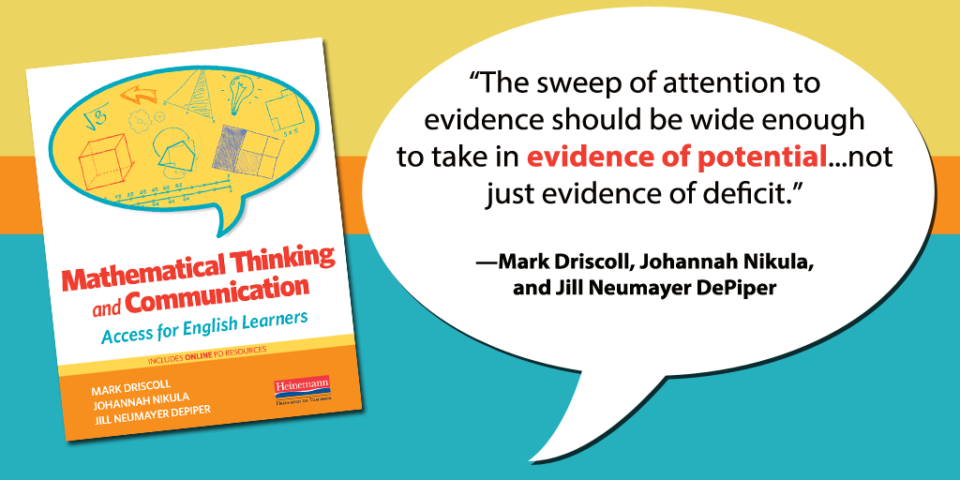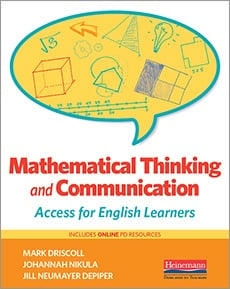
By Mark Driscoll, Johannah Nikula, and Jill Neumayer DePiper, adapted from their new book, Mathematical Thinking and Communication: Access for English Learners
As a general rule, mathematics teachers are experienced and frequently are experts in a particular kind of student work analysis. Often forced by time constraints to examine work quickly, they are able to see who is on the right track and who is not; how many students are getting side-tracked; where students are getting side-tracked; and who might need extra instructional attention. Often, this attention is directed toward students’ grasp of mathematics procedures and how to apply them.
All of this effort, in the real time of instruction, is essential to effective teaching practice. However, what often remain invisible in these hurried examinations of student work are the indications—perhaps small—of competence and potential in students’ mathematical thinking. Noticing such indications can be essential in providing English learners access to mathematical proficiency.
Analyzing student work is especially informative when the tasks are mathematically challenging; when they invite visual representations of the students’ work and descriptions of those representations; and when they inform and help structure teaching the next lesson.
The following are five important reminders about helpful and informative student-work analysis:
1. Focus on evidence.
Typically, there will be evidence of mathematical thinking as well as evidence of mathematical communication. With English learners, it is important to recall that evidence of mathematical thinking is distinct from evidence of mathematical communication. Put another way, a student may be thinking productively about a mathematical task but communicating about it with difficulty.
2. Don’t miss potential.
In the same vein, the sweep of attention to evidence should be wide enough to take in evidence of potential for competence in the student’s work on a task and not just evidence of deficit. Equitable instruction, we believe, is grounded in attention to both potential and needs.
3. Look for valued thinking.
The evidence sought in student-work analysis should be evidence of mathematical thinking that is valued. For a general framework of evidence of mathematical thinking, when tasks range across all of middle school mathematics, we have embraced the Common Core Standards of Mathematical Practice (SMP). Not only do they reach across the various mathematical domains, they also are intended to be the means by which the Common Core Mathematics Content Standards are put into action. Finally, we like the emphasis on practice, because that suggests each of the eight practices lives on a continuum, identifiable in early stages of development, as well as late.
4. Assess tasks that are already accessible.
For the benefit of English learners, and also for other students, the search for evidence related to mathematical communication should be guided by two elements: a language-development framework and the integration of language strategies with the mathematical-reasoning prompts in the tasks. Both help keep the tasks within access for most, if not all, English learners, and both are useful in managing the cognitive demands of mathematics tasks. For the language-development framework, we recommend the WIDA framework, which guides English learner policies and practices in many states, and which offers expectation markers for English learner students at different levels of English language proficiency.
5. Assess tasks that invite visual representations.
Collect student work to analyze on mathematics tasks that invite the use of visual representations. Embedding opportunities to use mathematical visual representations in classroom environments where teachers strive to notice evidence of students’ thinking, and build on that evidence to create equity in mathematics instruction, maximizes their value.
—
Interested in learning more about strategies that support English learners in math? Stay tuned to the Heinemann blog for more from Mark, Johannah, and Jill in the weeks ahead. You can also click here for a preview of their book.
♦ ♦ ♦ ♦
 Mark Driscoll, Johannah Nikula, and Jill Neumayer DePiper work in the Learning and Teaching Division at Education Development Center (EDC) in Massachusetts, a non-profit organization that designs, implements, and evaluates programs to improve education, health, and economic opportunity worldwide. They have decades of experience creating and studying professional development resources and training for mathematics teachers, with a particular focus on strategies to support the academic success of English learners.
Mark Driscoll, Johannah Nikula, and Jill Neumayer DePiper work in the Learning and Teaching Division at Education Development Center (EDC) in Massachusetts, a non-profit organization that designs, implements, and evaluates programs to improve education, health, and economic opportunity worldwide. They have decades of experience creating and studying professional development resources and training for mathematics teachers, with a particular focus on strategies to support the academic success of English learners.


